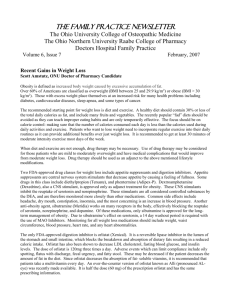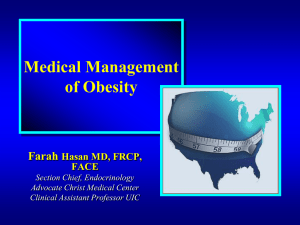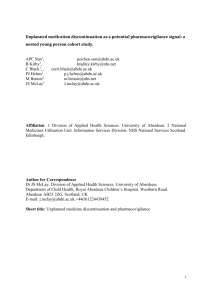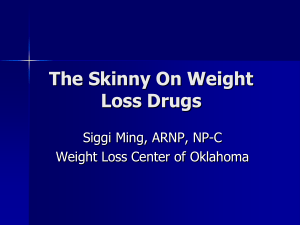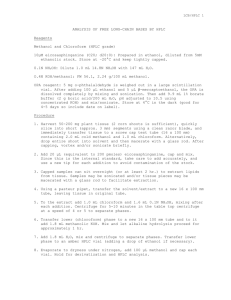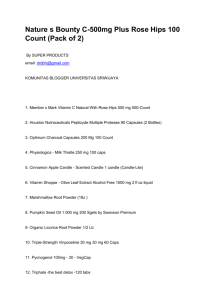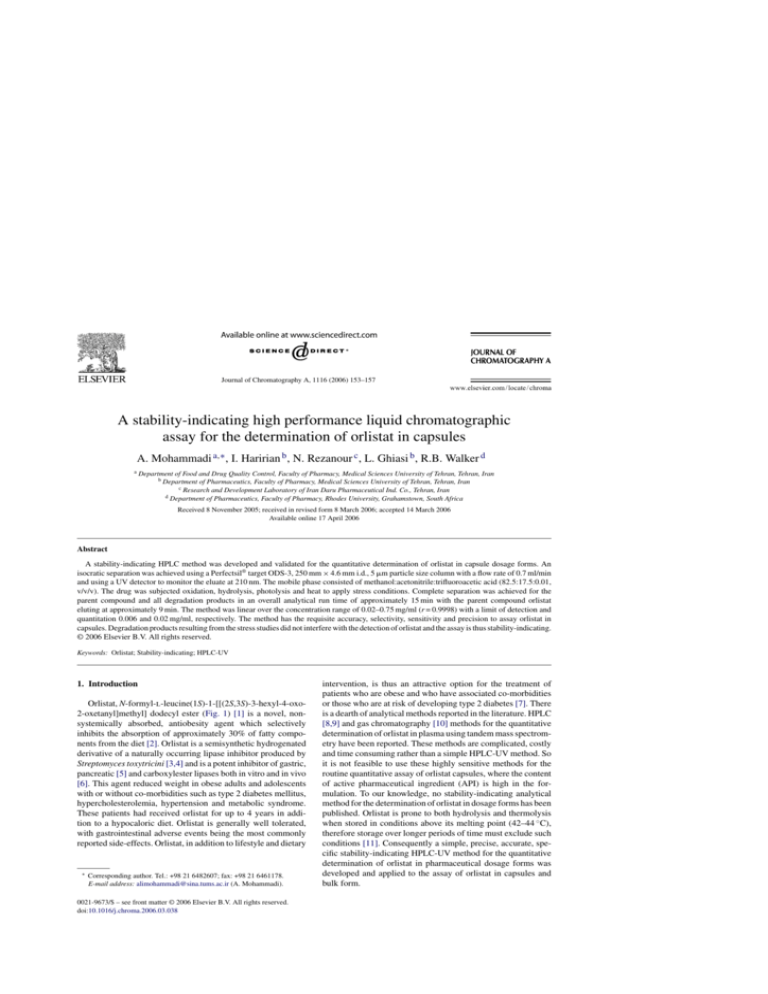
Journal of Chromatography A, 1116 (2006) 153–157
A stability-indicating high performance liquid chromatographic
assay for the determination of orlistat in capsules
A. Mohammadi a,∗ , I. Haririan b , N. Rezanour c , L. Ghiasi b , R.B. Walker d
a
Department of Food and Drug Quality Control, Faculty of Pharmacy, Medical Sciences University of Tehran, Tehran, Iran
b Department of Pharmaceutics, Faculty of Pharmacy, Medical Sciences University of Tehran, Tehran, Iran
c Research and Development Laboratory of Iran Daru Pharmaceutical Ind. Co., Tehran, Iran
d Department of Pharmaceutics, Faculty of Pharmacy, Rhodes University, Grahamstown, South Africa
Received 8 November 2005; received in revised form 8 March 2006; accepted 14 March 2006
Available online 17 April 2006
Abstract
A stability-indicating HPLC method was developed and validated for the quantitative determination of orlistat in capsule dosage forms. An
isocratic separation was achieved using a Perfectsil® target ODS-3, 250 mm × 4.6 mm i.d., 5 m particle size column with a flow rate of 0.7 ml/min
and using a UV detector to monitor the eluate at 210 nm. The mobile phase consisted of methanol:acetonitrile:trifluoroacetic acid (82.5:17.5:0.01,
v/v/v). The drug was subjected oxidation, hydrolysis, photolysis and heat to apply stress conditions. Complete separation was achieved for the
parent compound and all degradation products in an overall analytical run time of approximately 15 min with the parent compound orlistat
eluting at approximately 9 min. The method was linear over the concentration range of 0.02–0.75 mg/ml (r = 0.9998) with a limit of detection and
quantitation 0.006 and 0.02 mg/ml, respectively. The method has the requisite accuracy, selectivity, sensitivity and precision to assay orlistat in
capsules. Degradation products resulting from the stress studies did not interfere with the detection of orlistat and the assay is thus stability-indicating.
© 2006 Elsevier B.V. All rights reserved.
Keywords: Orlistat; Stability-indicating; HPLC-UV
1. Introduction
Orlistat, N-formyl-l-leucine(1S)-1-[[(2S,3S)-3-hexyl-4-oxo2-oxetanyl]methyl] dodecyl ester (Fig. 1) [1] is a novel, nonsystemically absorbed, antiobesity agent which selectively
inhibits the absorption of approximately 30% of fatty components from the diet [2]. Orlistat is a semisynthetic hydrogenated
derivative of a naturally occurring lipase inhibitor produced by
Streptomyces toxytricini [3,4] and is a potent inhibitor of gastric,
pancreatic [5] and carboxylester lipases both in vitro and in vivo
[6]. This agent reduced weight in obese adults and adolescents
with or without co-morbidities such as type 2 diabetes mellitus,
hypercholesterolemia, hypertension and metabolic syndrome.
These patients had received orlistat for up to 4 years in addition to a hypocaloric diet. Orlistat is generally well tolerated,
with gastrointestinal adverse events being the most commonly
reported side-effects. Orlistat, in addition to lifestyle and dietary
∗
Corresponding author. Tel.: +98 21 6482607; fax: +98 21 6461178.
E-mail address: alimohammadi@sina.tums.ac.ir (A. Mohammadi).
0021-9673/$ – see front matter © 2006 Elsevier B.V. All rights reserved.
doi:10.1016/j.chroma.2006.03.038
intervention, is thus an attractive option for the treatment of
patients who are obese and who have associated co-morbidities
or those who are at risk of developing type 2 diabetes [7]. There
is a dearth of analytical methods reported in the literature. HPLC
[8,9] and gas chromatography [10] methods for the quantitative
determination of orlistat in plasma using tandem mass spectrometry have been reported. These methods are complicated, costly
and time consuming rather than a simple HPLC-UV method. So
it is not feasible to use these highly sensitive methods for the
routine quantitative assay of orlistat capsules, where the content
of active pharmaceutical ingredient (API) is high in the formulation. To our knowledge, no stability-indicating analytical
method for the determination of orlistat in dosage forms has been
published. Orlistat is prone to both hydrolysis and thermolysis
when stored in conditions above its melting point (42–44 ◦ C),
therefore storage over longer periods of time must exclude such
conditions [11]. Consequently a simple, precise, accurate, specific stability-indicating HPLC-UV method for the quantitative
determination of orlistat in pharmaceutical dosage forms was
developed and applied to the assay of orlistat in capsules and
bulk form.
154
A. Mohammadi et al. / J. Chromatogr. A 1116 (2006) 153–157
pipettes into 10 ml volumetric flasks and the solutions were made
up to volume with mobile phase to give final concentrations of
0.02, 0.06, 0.1, 0.16, 0.2, 0.26, 0.3, 0.36, 0.5 and 0.75 mg/ml.
2.4. Preparation of capsules for assay
Fig. 1. Structural formulae for orlistat (MW = 495.7).
2. Experimental
2.1. Chemicals and reagents
Orlistat working standard powder was kindly supplied by
Hangzhoa Zhongmei Huadong Pharmaceutical Co., China and
was used without further purification. Orlistat capsules containing 120 mg orlistat as per label claim were purchased from a local
pharmacy. Xenical® (Roche, NJ, USA) capsules were used as the
reference formulation. Acetonitrile, methanol, triflouroacetic
acid, sodium hydroxide, hydrochloric acid and hydrogen peroxide were obtained from Merck (Darmstadt, Germany). All
chemicals were at least of analytical grade and used as received.
Purified HPLC grade water was obtained by reverse osmosis
and filtration through a Milli-Q® system (Millipore, Milford,
MA, USA) and was used to prepare all solutions.
2.2. HPLC instrumentation and conditions
The HPLC system consisted of a Waters® 600 controller solvent delivery module (Waters Chromatography Division, Milford, MA, USA), a Waters® 717 plus autosampler, a solvent
degasser, a Waters 2487 Dual λ absorbance detector (Waters
Chromatography Division, Milford, MA, USA). A Millenium®
(Waters Chromatography Division, Milford, MA, USA) Chromatographic Data System was coupled to the detector via a
SAT/IN Module (Waters Chromatography Division) and used to
record and evaluate the data collected during chromatographic
analysis. The chromatographic separation was performed using
a Perfectsil® target ODS-3, 5 m, 250 mm × 4.6 mm i.d. column. Separation was achieved using a mobile phase consisting
of methanol–acetonitrile–trifluoroacetic acid (82.5:17.5:0.01,
v/v/v) solution at a flow rate of 0.7 ml/min. The eluent was
monitored using UV detection at a wavelength of 210 nm. The
column was maintained at ambient temperature and an injection volume of 20 l was used. The mobile phase was filtered
through 0.45 m nylon filter prior to use.
2.3. Preparation of stock and standard solutions
A stock solution of orlistat (1 mg/ml) was prepared by accurately weighing approximately 20 mg of orlistat into a 20 ml
A-grade volumetric flask and making up to volume with HPLC
grade methanol. The stock solution was protected from light
using aluminium foil and stored for one week at 4 ◦ C and was
found to be stable during this period. Aliquots of the standard
stock solution of orlistat were transferred using A-grade bulb
Twenty capsules were opened and the contents weighed and
mixed. An aliquot of powder equivalent to the weight of one capsule was accurately weighed into a 100 ml volumetric flask and
made up to volume with HPLC-grade methanol. The volumetric
flasks were sonicated for 30 min to effect complete dissolution.
Suitable aliquots of solution were filtered through a 0.45 m
nylon filter. Suitable aliquot of the filtered solution was added
to a volumetric flask and made up to volume with mobile phase
to yield starting concentration of 0.2 mg/ml.
2.5. Forced degradation studies of API and capsule
contents
In order to determine whether the analytical method and assay
were stability-indicating, orlistat capsules and orlistat active
pharmaceutical ingredient (API) powder were stressed under
various conditions to conduct forced degradation studies [13].
As orlistat is practically insoluble in water and is very soluble in
methanol, methanol was used as co-solvent in all studies [14].
All solutions prepared for use in forced degradation studies were
prepared to yield starting concentrations of orlistat of 0.2 mg/ml.
In all cases, API (1 mg/ml) and capsule contents equivalent to
120 mg orlistat were accurately weighed and prepared for analysis as previously described.
2.5.1. Oxidation
Solutions for oxidation studies were prepared in methanol
and 3% H2 O2 (80:20, v/v) and the resultant solutions refluxed
for 30 min in order to facilitate oxidation of the orlistat.
2.5.2. Acid degradation studies
Solutions for acid degradation studies were prepared in
methanol and 2 M hydrochloric acid (80:20, v/v) and the resultant solutions refluxed for 30 min.
2.5.3. Alkali degradation studies
Solutions for alkali degradation studies were prepared in
methanol and 2 M, sodium hydroxide (80:20, v/v) and the resultant solutions refluxed for 30 min.
2.5.4. Neutral degradation studies
Solutions for neutral degradation studies were prepared in
methanol and water (80:20, v/v) and the resultant solutions
refluxed for 3 h.
2.5.5. Temperature stress studies
Capsules and API powder were exposed to dry heat (60 ◦ C) in
an oven for 3 days. The capsules and API powder were removed
from the oven and the contents of 20 capsules were removed
and mixed. An aliquot of powder equivalent to the weight of
A. Mohammadi et al. / J. Chromatogr. A 1116 (2006) 153–157
one capsule and API powder were then prepared for analysis as
previously described.
2.5.6. Photostability
Orlistat API, capsule contents and solutions of orlistat were
prepared and exposed to light to determine the effects of light
irradiation on the stability of orlistat in solution and in the solid
state. Approximately 50 mg of orlistat API powder was spread
on a glass dish in a layer that was less than 2 mm thick. A solution
of API (1 mg/ml) was prepared in Methanol and Water (80:20,
v/v). Capsules were prepared in the same way. All samples for
photostability testing were placed in a light cabinet (Suntest
CPS/CPS+ , Atlas Material Testing Technology, Germany) and
exposed to light for 40 h resulting in an overall illumination of
≥210 W h/m2 at 25 ◦ C with UV radiation at 320–400 nm. Control samples which were protected with aluminium foil were also
placed in the light cabinet and exposed concurrently. Following
removal from the light cabinet, all samples were prepared for
analysis as previously described.
3. Results and discussion
3.1. HPLC method development and optimization
Herein a novel sorbent material is used and validated
for the determination of orlistat. PerfectSil® Target (MZAnalysentechnik, Mainz, Germany) is an ultra pure silica gel
(>99.999%) provided with novel state of the art bonding and end
capping technology that is characterized by excellent chemical
and mechanical stability and provides excellent peak symmetry for basic analytes. A significant advantage is that it can be
used even for 100% aqueous applications. The stressed samples were initially analyzed using a mobile phase consisting
of methanol–acetonitrile (82.5:17.5) at a flow rate of 1 ml/min.
Under these conditions, as the separation and peak shape were
not optimal, the flow rate was changed from 1 to 0.7 ml/min.
An improvement was observed in the separation, but the peak
shape was still unsatisfactory. An attempt to improve peak
shape was made by adding trifluoroacetic acid (TFA) to the
mobile phase. The presence of the TFA in the mobile phase
resulted in excellent overall chromatography with appropriate peak symmetry and complete baseline resolution. Eventually, a mobile phase of methanol:acetonitrile:trifluoroacetic
acid (82.5:17.5:0.01, v/v/v) provided the best chromatographic
response and was used for further studies.
3.2. Validation
The method was validated with respect to parameters including linearity, limit of quantitation (LOQ), limit of detection
(LOD), precision, accuracy, selectivity and recovery.
3.2.1. Linearity
The calibration curves (n = 3) constructed for orlistat were
linear over the concentration range of 0.02–0.75 mg/ml. Peak
areas of orlistat were plotted versus orlistat concentration and
linear regression analysis performed on the resultant curve.
155
Table 1
Intra- and inter-assay precision data (n = 9)
Actual concentration
(mg/ml)
Measured concentration (mg/ml), RSD (%)
Intra-day
Inter-day
0.02
0.15
0.75
0.0205, 2.30
0.1520, 1.24
0.7500, 0.42
0.020, 3.33
0.153, 3.59
0.752, 2.70
Data expressed as mean for “measured concentration” values.
Three correlation coefficients of R1 = 0.9998, R2 = 0.9997 and
R3 = 0.9998 with %RSD values ranging from 0.28 to 3% across
the concentration range studied were obtained following linear
regression analysis. Typically, the regression equation for the
calibration curve was found to be y = 0.023X + 0.007.
3.2.2. LOQ and LOD
The LOQ and LOD were determined based on a signal-tonoise ratios and were based on analytical responses of 10 and
3 times the background noise, respectively [15]. The LOQ was
found to be 0.02 mg/ml with a resultant %RSD of 0.4% (n = 5).
The LOD was found to be 0.006 mg/ml.
3.2.3. Precision
Precision of the assay was investigated with respect to both
repeatability and reproducibility. Repeatability was investigated
by injecting nine replicate samples of each of the 0.02, 0.15
and 0.75 mg/ml standards where the mean concentrations were
found to be 0.0205, 0.152 and 0.75 with associated %RSDs of
2.3, 1.24 and 0.42, respectively. Inter-day precision was assessed
by injecting the same three concentrations over 3 consecutive
days, resulting in mean concentrations of orlistat of 0.02, 0.153
and 0.752 mg/ml and associated %RSD of 3.33, 3.59 and 2.7%,
respectively. The ruggedness of the method was assessed by
comparison of the intra- and inter-day assay results for orlistat
undertaken by two analysts. The %RSD values for intra- and
inter-day assays of orlistat in the cited formulations performed
in the same laboratory by the two analysts did not exceed
4%, thus indicating the ruggedness of the method (Table 1).
The mean retention time of orlistat was 9 min with %RSD
of 0.1%.
3.2.4. Accuracy
Accuracy of the assay was determined by interpolation of
replicate (n = 6) peak areas of three accuracy standards (0.02,
0.15 and 0.75 mg/ml) from a calibration curve prepared as
previously described. In each case, the percent relevant error
and accuracy was calculated. The resultant concentrations were
0.0206 ± 0.0002 mg/ml (mean ± SD), 0.152 ± 0.003 mg/ml and
0.754 ± 0.005 mg/ml with percent relevant errors of 3.1, 1.2 and
0.53%, respectively.
3.2.5. Selectivity
The results of stress testing studies indicated a high degree of
selectivity of this method for orlistat. The degradation of orlistat
was found to be similar for both the capsules and API powder.
156
A. Mohammadi et al. / J. Chromatogr. A 1116 (2006) 153–157
Fig. 3. Resultant HPLC chromatograms following the analysis of a standard
solution of orlistat (A) (0.2 mg/ml) and Xenical® capsules (B) showing orlistat
(1).
Fig. 2. Typical HPLC chromatograms of: (A) acid hydrolysis-degraded active
pharmaceutical ingredient (API); (B) neutral-hydrolysis degraded API; (C) photodegraded API; (D) oxidative degraded API; (E) base hydrolysis-degraded API;
and (F) untreated API showing orlistat (1).
Typical chromatograms obtained following the assay of pure
bulk sample and stressed samples are shown in Fig. 2.
3.2.6. Recovery
A known amount of orlistat standard powder was added to
aliquots (n = 20) of capsule contents, mixed and the powder
was extracted and diluted to yield a starting concentration of
0.3 mg/ml as previously described in Section 2.4. This solution
was analyzed as previously described. The assay was repeated
(n = 9) over 3 consecutive days to obtain intermediate precision
data. The observed concentration of orlistat was found to be
0.299 ± 0.0035 mg/ml (mean ± SD). The resultant %RSD for
this study was found to be 1.18% with a corresponding percentage recovery value of 99.9%.
3.2.7. Stability studies
Orlistat is characterized by an aliphatic hydrocarbon backbone bearing a -lactone moiety and a N-formyl-l-leucyl side
chain in ␦-position to the lactone C O C-atom and was suspected
to be unstable at high temperature and prone to hydrolysis. Its
thermal and hydrolytic degradation have been reported, and all
main degradation products isolated, characterized and synthesized [11]. The orlistat degradation products produced by human
carboxyl ester lipase have also been described [12]. All stressed
samples in both solid and solution state remained colorless.
Orlistat was found to be stable under dry heat condition. No
decomposition was seen on exposure of solid drug powder to
light in a phptostability chamber, whereas photolytic exposure
of orlistat API and capsules in methanol and water (80:20, v/v)
resulted in 48 and 47.6% decomposition, respectively. The drug
was more unstable under acidic stress condition, falling by 95%
upon refluxing to 30 min. Orlistat was relatively stable to oxidation. On refluxing the drug in methanol and 3% H2 O2 (80:20,
v/v) for 30 min, around 23% of drug was only degraded. In spite
of acidic condition, the drug was found to be more stable in alkaline condition falling by 48% upon refluxing up to 30 min. Three
hours after refluxing the drug in methanol and water (80:20, v/v),
60% of drug was degraded. The stability of the stock solution was
determined by quantitation of orlistat and comparison to freshly
prepared standard. No significant change (<2%) was observed
in stock solution response, relative to freshly prepared standard
(data not shown).
3.2.8. Assay
The proposed method was applied to the determination of
orlistat in a generic brand of orlistat and Xenical® capsules. A
typical chromatogram obtained following the assay of Xenical®
capsules is depicted in Fig. 3. The result of these assays yielded
100.01% (%RSD = 1.80%) and 99.98% (%RSD = 2.4%) of label
claim for the generic brand and Xenical® capsules, respectively.
The results of the assay indicate that the method is selective
for the assay of orlistat without interference from the excipients
used in these capsules.
4. Conclusions
A validated stability-indicating HPLC analytical method has
been developed for the determination of orlistat in API and
dosage forms. The results of stress testing undertaken according
to the International Conference on Harmonization (ICH) guide-
A. Mohammadi et al. / J. Chromatogr. A 1116 (2006) 153–157
lines reveal that the method is selective and stability-indicating.
The proposed method is simple, accurate, precise, specific, and
has the ability to separate the drug from degradation products and
excipients found in the capsule dosage forms. The method is suitable for use for the routine analysis of orlistat in either bulk API
powder or in pharmaceutical dosage forms. The simplicity of the
method allows for application in laboratories that lack sophisticated analytical instruments such as LC–MS [8,9] or GC–MS
[10]. These methods are complicated, costly and time consuming
rather than a simple HPLC-UV method. In addition, the HPLC
procedure can be applied to the analysis of samples obtained
during accelerated stability experiments to predict expiry dates
of pharmaceuticals.
References
[1] M.J. ONeil, A. Smith, P.E. Heckelman, S. Budavari, The Merck Index,
An Encyclopedia of Chemicals. Drugs and Biologicals, 13th ed., Merck
& Co. Inc., White House Station, New Jersey, 2001, p. 1228.
[2] L.J. Aronne, J. Am. Diet. Assoc. 98 (1998) A13.
[3] E.K. Weibel, P. Hadvary, E. Hochuli, E. Kupfer, H. Lengsfeld, J.
Antibiot. 40 (1987) 1081.
157
[4] E. Hochuli, E. Kupfer, R. Maurer, W. Meister, Y. Mercadel, K. Schmidt,
J. Antibiot. 40 (1987) 1086.
[5] S.C. Sweetman, Martindale the Complete Drug Reference, 34th ed.,
Pharmaceutical Press, London, 2005, p. 1724.
[6] J.B. Harp, J. Nutr. Biochem. 9 (1998) 516.
[7] M.P. Curran, L.J. Scott, Drugs 64 (2004) 2845.
[8] P.K. Bennett, Y.T. Li, R. Edom, J. Henion, J. Mass Spectrom. 32 (1997)
739.
[9] R. Wieboldt, D.A. Campbell, J. Henion, J Chromatogr. B: Biomed. Sci.
Appl. 708 (1998) 121.
[10] W.A. Garland, Determination of Tetrahydrolipostatin (Ro 18-0647)
in Human plasma by Positive Ion Ammonia Chemical Ionization
GC/MS/MS, Report MS-32, Hoffman–La Roche, Nutley, NJ, 1990.
[11] H. Stalder, P.R. Schneider, G. Oesterhelt, Helv. Chim. Acta 73 (1990)
1022.
[12] H. Stalder, G. Oesterhelt, B. Borgstroem, Helv. Chim. Acta 75 (1992)
1593.
[13] ICH Stability Testing of New Drug Substances and Products (Q1AR2),
International Conference on Harmonization, IFPMA, Geneva, 2003.
[14] A.C. Moffat, M.D. Osselten, B. Widdop, Clarke’s Analysis of Drugs
and Poisons in Pharmaceuticals. Body Fluids and Postmortem Material,
third ed., Pharmaceutical Press, London, 2004, p. 1370.
[15] ICH Draft Guidelines on Validation of Analytical Procedures: Definitions and Terminology, Federal Register, vol. 60, IFPMA, Switzerland,
1995.

